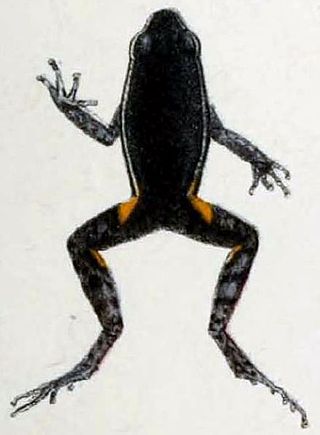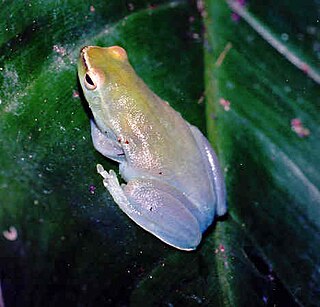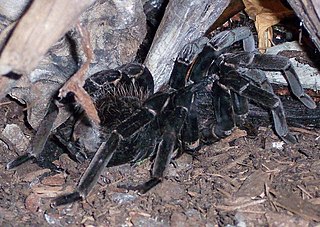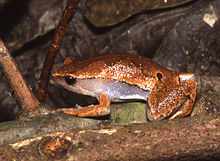
Sachatamia ilex is a species of frog in the family Centrolenidae. It is found in eastern Nicaragua, Costa Rica, Panama, western Colombia, and western Ecuador. The common name Limon giant glass frog has been coined for this species, apparently in reference to its type locality in the canton of Limón, Costa Rica, and it is also known as Holly's glassfrog and the ghost glass frog.
"Centrolene" medemi is a species of frog in the family Centrolenidae. The species occurs in the Cordillera Oriental in the Tolima, Caquetá, and Putumayo Departments in Colombia and adjacent Napo in Ecuador. The generic placement of this species within the subfamily Centroleninae is uncertain. The specific name medemi honors Fred Medem, collector of the holotype. Common name Medem giant glass frog has been coined for it.

Cochranella resplendens is a species of frog in the family Centrolenidae. It is found in the upper Amazon Basin in southwestern Colombia, eastern Ecuador, northern Peru, and Bolivia. There are also isolated records from the Cordillera Central in Antioquia, Colombia, and Amapá in northern Brazil. The specific name resplendens is derived from the Latin verb resplendo and hints to the jewel-like appearance of this frog. It is sometimes known as the resplendent Cochran frog or resplendent glassfrog.

Ameerega hahneli is a species of frog in the family Dendrobatidae. It is found in the Amazonian lowlands of Brazil, Bolivia, Peru, Ecuador, Colombia, Venezuela, Guyana, French Guiana, and Suriname. It is named after Paul Hahnel, the collector of the type series.

Dendropsophus marmoratus is a species of frog in the family Hylidae. It is found in the Amazon rainforest and montane forests in the eastern piedmont, in Bolivia, Brazil, Colombia, Ecuador, French Guiana, Guyana, Peru, Suriname, and Venezuela. Its natural habitats are subtropical or tropical moist lowland forests, intermittent freshwater marshes, and heavily degraded former forest. "Marmoratus" in Latin means "marble," perhaps referring to the dorsal coloring pattern. It is threatened by habitat loss.
Dendropsophus riveroi is a species of frog in the family Hylidae. It is found in the upper Amazon Basin in western Brazil, Bolivia, Peru, Ecuador, and southern Colombia. In Ecuador it has been mixed with the newly described Dendropsophus shiwiarum. The specific name honours Juan A. Rivero.

Osteocephalus buckleyi, also known as Buckley's slender-legged treefrog, is a species of frog in the family Hylidae. It is found along the periphery of the Amazon Basin in Bolivia, Peru, Ecuador, Colombia, northeastern Brazil, Venezuela, Guyana, Suriname, and French Guiana, and also in the Orinoco Delta in Venezuela. It is probably a species complex. Some sources treat Osteocephalus vilmae from Ecuador and Peru as a valid species.
Osteocephalus deridens is a species of frog in the family Hylidae. It is found in the Napo and Pastaza River drainages in eastern Ecuador and in the Loreto Region, northern Peru. The specific name deridens is derived from Latin deridere, meaning "make fun of someone". This alludes to the males calling from the treetops that sound "as if they are laughing at the collectors' vain attempts to reach them". Common name funny slender-legged treefrog has been coined for this species.

Callimedusa atelopoides is a species of frog in the subfamily Phyllomedusinae. It is known from Amazonian Bolivia, Brazil, and Peru, and is likely to be found in adjacent Colombia and Ecuador. Common name toady leaf frog has been proposed for it.

Scinax ruber is a species of frog in the family Hylidae which is known in English as the red snouted treefrog or red-snouted treefrog, sometimes also Allen's snouted treefrog, the latter referring to the now-synonymized Scinax alleni. This widespread species is found in much of Amazonian and northern coastal South America and into Panama, as well as in some Caribbean islands as introduced populations. It is a complex containing several cryptic species.

Sphaenorhynchus dorisae, the Doris' lime treefrog, is a species of frog in the family Hylidae. It is found in the upper Amazon Basin of southeastern Colombia, Ecuador, Brazil and Peru. It might also be present in Bolivia.

Sphaenorhynchus lacteus, the Orinoco lime treefrog or greater hatchet-faced treefrog, is a species of frog in the family Hylidae. It is a widely distributed species found in the Orinoco and Amazon basins in Venezuela, the Guianas, Colombia, Brazil, Ecuador, Peru, and Bolivia. It also occurs in Trinidad and Tobago.
Niceforonia dolops is a species of frog in the family Strabomantidae. It is found in the Andes of southern Colombia and northern Ecuador. Specifically, it is known from the Cordillera Oriental and Colombian Massif in Caquetá and Putumayo Departments, Colombia, and Napo Province, Ecuador. Common name Putumayo robber frog has been coined for it.
Pristimantis eremitus is a species of frog in the family Strabomantidae. It is found in the Cordillera Occidental in north-western Ecuador from the Cotopaxi Province northward and on western slope of the Colombian Massif in the Nariño Department, extreme south-western Colombia. The specific name eremitus is Latin for "lonely" or "solitary" and refers to this species being the only western-Andean species among its closest relatives. Common names Chiriboga robber frog and lonely rainfrog have been coined for it.
Hemiphractus proboscideus, or the Sumaco horned treefrog, is a species of frog in the family Hemiphractidae. It is found in the upper Amazon basin in extreme southwestern Colombia, Ecuador, and northern Peru.
Noblella myrmecoides is a species of frog in the family Strabomantidae. It is found in the upper Amazon Basin of southeastern Colombia, eastern Ecuador, eastern Peru, Bolivia, and western Brazil (Amazonas). Common name Loreto leaf frog has been coined for this species.

Leptodactylus discodactylus is a species of frog in the family Leptodactylidae. It is found in the Amazonian Bolivia, Brazil, Peru, Ecuador, and Colombia.

Chiasmocleis ventrimaculata, also known as the dotted humming frog, is a species of frog in the family Microhylidae. It is found in Bolivia, Brazil, Colombia, Ecuador, and Peru. Its natural habitats are subtropical or tropical moist lowland forests, swamps, and intermittent freshwater marshes.

Xenesthis immanis, the Colombian lesser black tarantula, is a terrestrial bird spider (tarantula) found in Colombia, Venezuela, and Peru. It is a relatively large spider with a body length reaching 6–7 cm and a length width reaching 19–22 cm. It frequently displays a commensal or mutualistic relationship with the microhylid frog Chiasmocleis ventrimaculata. The relationship described is one where the spider may protect the frog and its eggs from predators while the frog protects the spider's eggs from ants. It has also been observed closely associating with Hamptophryne boliviana, another microhylid.
Boana nympha is a species of frog in the family Hylidae. It is endemic to the upper Amazon basin of southern Colombia, eastern Ecuador, and northeastern Peru; its range probably extends into adjacent western Brazil. The specific name nympha alludes to nymphs, beautiful wood- and marsh-dwelling goddesses in Greek mythology. Common name nympha Amazon treefrog has been proposed for it.














